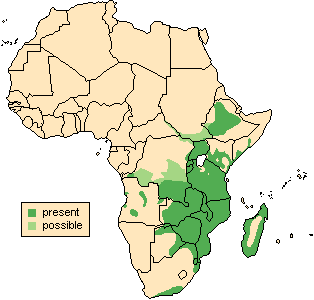![]() Return
to Artiodactyla
Return
to Artiodactyla
Classification
|
 Potamochoerus
larvatus
Potamochoerus
larvatus
Bush pig
![]()
Taxonomy
 |
 |
 |
Click on the pictures above for a larger view of the
photographs
|
||
General Characteristics
Body Length: 100-150 cm / 3.3-5 ft.
Shoulder Height: 55-80 cm / 1.8-2.7 ft.
Tail Length: 30-43 cm / 12-17 in.
Weight: 54-115 kg / 119-253 lb.Unlike the red river hog, the coat of the bush pig is shaggy and varies in colour from light reddish brown to gray-brown to almost black. The long, bristly hairs form a distinct, partially erectile mane or cape over the dorsal part of the animal, starting between the ears and extending to the rear. The paler head is often found with contrasting white markings, although nowhere to the extend of the red river hog, while the ears having moderate tassels at their tips. Young are born with brown and yellow stripes, which they gradually lose over several months. The tail is long and tufted at the tip. The body is round and the legs relatively short. Males have a bony ridge and warts on the snout. The upper tusks are barely visible, but the lower tusks are razor sharp and grow 7 cm / 3 in. long.
Ontogeny and Reproduction
Gestation Period: 120-127 days.
Young per Birth: 1-4, rarely 6.
Weaning: At 2-4 months.
Sexual Maturity: At 18-21 months.
Life span: 20 years.Most births occur in the spring (September-November), just before the onset of the rainy season. Just before giving birth, the female retires to a sheltered nest or hollow.
Ecology and Behavior
The predominantly nocturnal behaviour of the bush pig is believed to be related to the ambient temperature, as diurnal activity occurs more frequently in the cooler months. Shelter in which to rest is most often found in dense vegetation, and nests may be built during the rains or cold spells. Wallowing is a favourite activity. Bush pigs are often found following frugivorous monkeys, feeding off of discarded fruits, and are notorious for feeding on crops. The most common vocalization is a grunt, with squeals and roars being infrequently emitted. Contests between animals generally consist of forehead shoving matches. Daily movements vary from 0.5-5 kilometers / 0.3-3 miles per day. Groups inhabit home ranges up to 10 square kilometers in area, which are fairly exclusive. Population densities vary from 0.3-10.1 animals per square kilometer.Family group: Sounders of 2-10 females and young attended by a male.
Diet: Grasses, water plants, roots, bulbs, fruit, carrion, small animals.
Main Predators: Humans, leopard, lion, spotted hyena, python.
Distribution
Montane forests, moist woodlands, grasslands, and swamps in eastern Africa and Madagascar.

Range Map (Redrawn from Vercammen et al., 1993)
Conservation Status
The bush pig is widespread and abundant through most of its range.
Remarks
Widely adaptable, this hog is believed to have been introduced onto Madagascar and the Comoro islands, where it is now thriving. Until recently, the bush pig was classified as a subspecies of the red river hog, Potamochoerus porcus. Potamos (Greek) a river; khoiros (Greek) a pig: they are fond wallowing in water in hot weather. Larva (Latin) a ghost, can mean a mask; -atus (Latin) suffix meaning 'provided with': "having a mask".
Literature Cited
Kingdon, J. 1997. The Kingdon Field Guide to African Mammals. Academic Press, London and New York: NaturalWorld.Vercammen, P., A. H. W. Seydack, and W. L. R. Oliver. 1993. The bush pigs (Potamochoerus porcus and P. larvatus). In Pigs, Peccaries and Hippos: Status Survey and Action Plan. Edited by W. L. R. Oliver. Gland, Switzerland: IUCN. pp. 93-101. Available online at http://iucn.org/themes/ssc/sgs/pphsg/Contents.htm
Wilson, D. E., and D. M. Reeder [editors]. 1993. Mammal Species of the World (Second Edition). Washington: Smithsonian Institution Press. Available online at http://nmnhwww.si.edu/msw/
Return to Artiodactyla

![]()
© Brent Huffman, www.ultimateungulate.com |
|
|